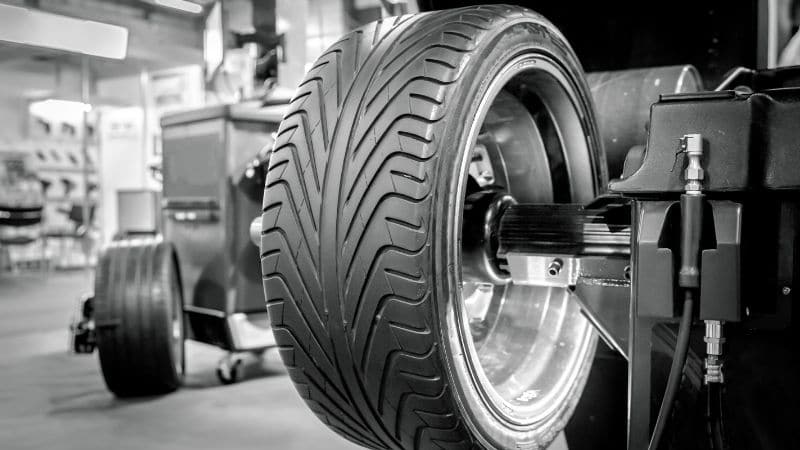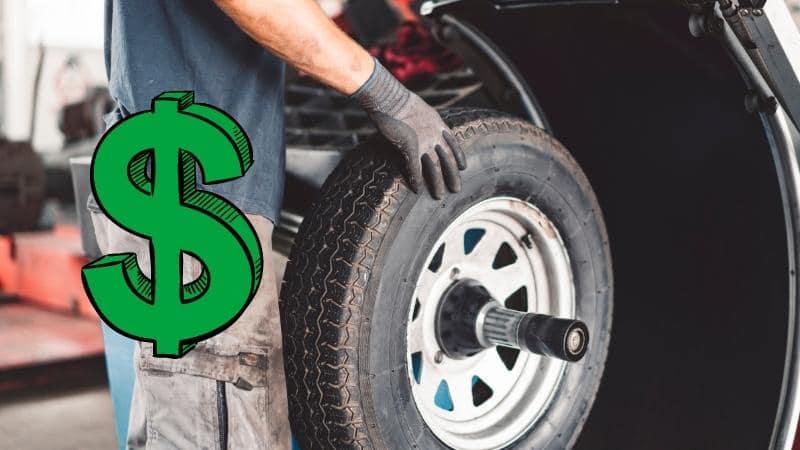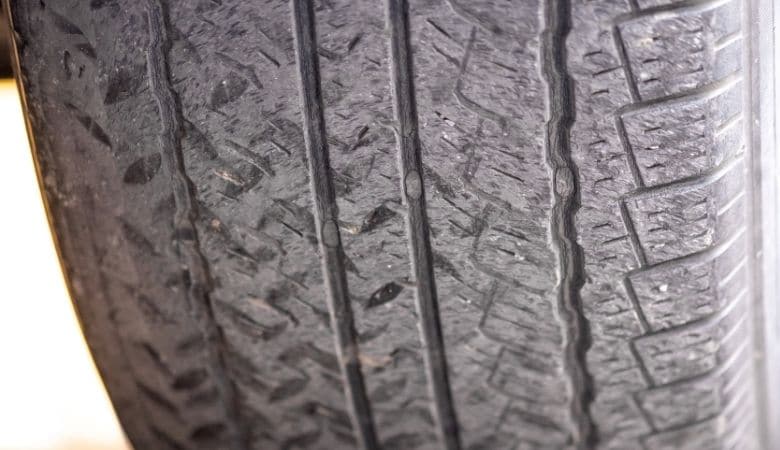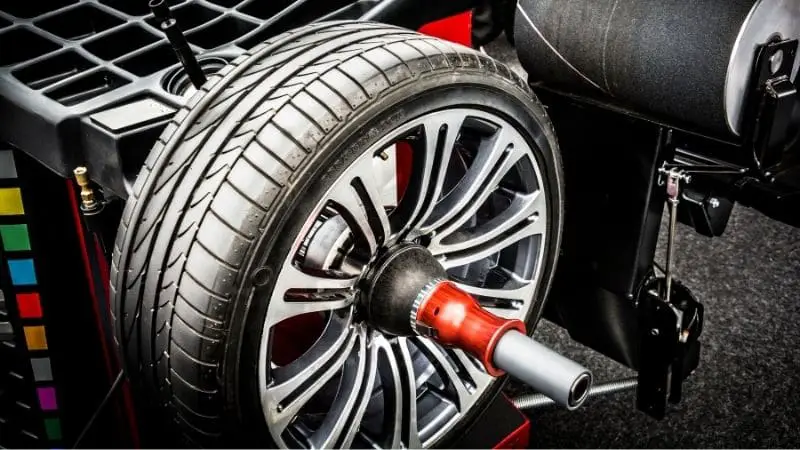Out-of-balance tires may seem like a small thing, but they can cause early suspension and tire wear.
Therefore, tire balancing is a critical procedure. If your wheels do not balance regularly, they may worsen your cars handling and safety.
Continue reading this post to know more about wheel balancing, why you should do it and signs that show your tire needs balancing.
What is Wheel Balancing?
Before we go into details about wheel balancing, you need to understand precisely what it is. Modern wheels come with small weights fixed on them close to the edges of your tires when they are mounted.
Such weights help to distribute the weight of the wheel evenly. Wheel balancing is done by adjusting these weights to ensure each tire is equally balanced.

It is wise to understand that wheel balancing and wheel alignment are different. Both are important, but they perform different functions to your wheels. Wheel balancing regulates the weights and their dispersion on the wheel itself.
On the other hand, tire alignment, also called wheel alignment, is done to adjust your vehicle’s suspension to correct the inclination of your wheels on your car. This ensures the correct contact between the rubber and the road for safe and secure driving.
However, today we will only focus specifically on tire/wheel balancing.
5 Reasons Why You Should Balance Your Wheels

When it comes to our automotive, we are always after saving money in the long run. This means to try putting off or avoiding services we know we should not. One of such services is balancing the tires.
There are several reasons why you should balance your wheels. In addition to ensuring safety, balancing your wheels provides a smooth ride and extends your car life. Here are some reasons why you should balance your wheels.
1. Balanced Wheels Provide a Smoother Ride
The most noticeable benefit of balanced wheels is that your vehicle will ride smoother. When the weight on the wheels exceeds the limit, you will realize vibrations in your car. These vibrations are mostly felt when at high speeds.
2. Balanced Wheels Improves Gas Mileage
Balancing wheels have a lot of benefits apart from improving the quality of your ride. It significantly improves your gas mileage. Your wheels won’t drive smoothly if they are unbalanced.
Same as how maintaining your tire pressure enhances gas mileage, balancing your tires do so as well. Having even weight distribution across your wheels will prevent wear that may eventually reduce your vehicle’s fuel efficiency. This will save you money in the long run.
3. Improves Tire Life
We had explained how unbalanced wheels wear down unevenly. Therefore, it is not surprising that uneven tear and wear can reduce your tire’s life. Out-of-balance tires, uneven tread wear, and excessive vibrations can cause your tires to wear out faster.
4. Protects Your Vehicles Suspension
Out-of-balance wheels are bad for more than treads and gas mileage. It also affects your vehicle’s Suspension. With time, the vibrations from your unbalanced tires will continue getting worse.
Such vibrations would finally affect your vehicle’s Suspension. Though balancing tires is an easy task going for less than $100, neglecting the problem may cost you much more down the line.
5. Guarantees a Safer Ride
This is the most essential benefit of balancing your wheels as you will enjoy a safe rider and ensure your car’s safety. Unbalanced tires can develop uneven tread wear and dangerous bald spots.
This will make it harder to control your car’s steering, mostly at highway speeds. Regular maintenance such as wheel balancing will ensure your vehicle is in top shape every time.
What Happens if You Drive With Unbalanced Wheels?
Have you ever heard your mechanics informing you that your wheels are out of balance? If you are not conversant with the term, it may sound like a new diagnosis for you. You may wonder to what extent this problem is and if it is safe to drive without balanced tires.
Driving with unbalanced tires is not that dangerous, and it does not require immediate action. However, unbalanced tires can cause more serious issues in the long run. Therefore, it is always wise to have them balanced as soon as possible.
How Often Should You Balance Your Wheels?
The moment you notice any signs of unbalanced wheels, you should correct the problem as soon as possible. Otherwise, you will be subjecting yourself, your passengers and your vehicle to risk.
Apart from regular maintenance, it is good to watch out for the warning signs below and have your wheels balanced sooner rather than later.
- Unevenly wear and bald spots
- Unusual chassis vibration
- Shaking of the steering wheel
- Lower gas mileage
How Much Does Wheel Balancing Cost?

On average, wheel balancing cost ranges from $30 to $100 for your vehicle’s four wheels. Nonetheless, you can spend $10 to $15 per tire according to the charges offered by your mechanic to make your vehicle.
It is essential to understand that tire balancing services are more costly at car dealers than in tire shops, alignment shops, Costco, or independent auto repair shops.
For example, a typical tire shop chain can balance all your four wheels at an average cost of $15 per wheel. On the other hand, you can have your four tires balanced at a car dealership for about $20 to $25 per tire, depending on tire make and model.
A complete tire balancing involves both wheel mounting and wheel rotation. Tire rotation is the process of changing the specific positions of individual wheels, while tire mounting is the act of placing the tire on the wheel.
Is Wheel Balancing The Same as Wheel Alignment?
Have you wondered if there is any difference between “wheel balancing” and “wheel alignment”? Then, you are not alone. Most people often do not understand that these are two different processes.
Wheel balancing checks on how a wheel rotates on its center, while wheel alignment refers to the direction of the wheel in relation to each other and the center point of the tire.
On a well-balanced wheel, every point on the wheel experiences equal weights. Unequal weight distribution will result in an unequal centrifugal force that will cause varying vibrations on the wheel.
Though both processes should be done regularly, wheel balancing is not the same as wheel alignment. A wheel alignment will adjust the angles of the wheels such that they move in the same direction and make proper contact with the surface.
How Long Does Wheel Balancing Take?
How long does wheel balancing take? This question is common to many new vehicle owners and new drivers. However, we will answer this question and shed more light on tire balancing.
Usually, wheel balancing may take between 40 minutes and 2 hours, according to several factors. Such factors include but are not limited to your driving habits, tire condition, and weather conditions you drive in.
For instance, balancing wheels that have hit a pothole may take a longer time than balancing new wheels. Other inspections and waiting time can also add to the duration spent at an auto repair shop.
What Are the Signs of Out-of-Balanced Tires?
Everyday tread wear will cause an imbalance in your tires. Normal manufacturing flaws such as unequal weight distribution on tires may also contribute.
A small amount of imbalance can affect how your vehicle handles and feels. Below are some of the common signs of out-of-balance tires.
1. Strange Tread Wear

With time, a poorly balanced wheel leads to unusual, irregular flat areas in a tire’s tread. Such wear patches do not have consistency in shape and size.
If you don’t correct the problem at the early stages, then your tires will end up with lost treads. Uneven wear can result in a blowout as it affects the integrity of the sidewalls and tire strength after time.
2. Weird Vibrations
An abrupt appearance of vibrations indicates that your wheels are out of balance. You will notice such vibrations in your steering wheel the moment you reach reasonable speeds.
The vibrations will worsen as your speed increases and then smooth out at high speed.
3. Fluctuations in Gas Mileage
Unusually worn tires and vibrations can diminish your gas mileage significantly as you accelerate. Nevertheless, check for underinflation as it is common for increased fuel consumption.
4. Worn Suspension parts
The vibration from out-of-balance wheels echoes through the suspension system and the rest of the wheel. This will lead to damage and early wear to the tire shocks and bearings in the long run.
It also affects your car handling and responsiveness. With time, you will notice strange noises from the bearings or more looseness (or play) in your steering.
What Are The Methods of Wheel Balancing?
Wheel balancing can only be done in two ways; standard balancing and road force balancing.
Standard balancing is spinning the tire to be accessed by a balancing machine. The machine will therefore indicate if there is an imbalance. If there is, several weight objects are placed strategically to work against the unbalanced weight.
On the other hand, road force balancing involves simulation. This is where the vehicle wheels are subjected to a condition similar to what they undergo on the road. Then a wheel balancing machine using a tool known as a load roller turns the wheel till it is balanced.
Conclusion
This is the basic knowledge of wheel balancing and everything you should know about your car’s wheels.
Tire balancing rotates around weight, and if anything is a little bit off, it can significantly affect how your vehicle drives. Our advice is always to ensure that your tires are well-balanced and in good condition.
Hi, my name is Niklas, the head content creator & CEO of Whirling Wheelz. I am very interested in vehicles of all kinds, mainly cars. I have a car mechanics degree from high school and a big hobby of mine is to follow the WRC (World Rally Championship) both online and through travel.

